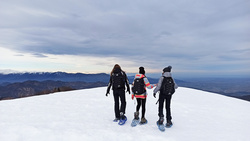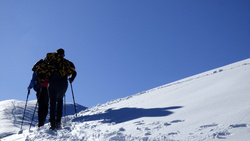TECHNIQUE AND ADVICE


Snowshoeing is probably the simplest and easiest winter sport to learn, as it is comparable to walking in summer on marked trails and in normal conditions, only the knees need to be raised more to prevent the snowshoes from catching on each other. In fact, modern equipment, aided by the poles used in skiing, allows you to walk naturally without any particular technical skills. However, you will have to take into account a greater physical effort due to the reduced weight of the equipment and the type of snow you encounter.
On both ascents and descents, the heel should not be blocked except in rare cases, such as when jumping over obstacles; it is useful to avoid long traverses on slopes, especially in hard snow, as the snowshoe does not tolerate partial support of its surface and the ankles could suffer. A "zig-zag" ascent is recommended as it allows you to alternate the effort on your limbs without tiring the muscles for a long time, or, on short and not excessively steep slopes, a "duck" ascent, i.e. facing the slope and placing your skis slightly apart. Descents should normally be tackled, overcoming natural fear, at maximum gradient with more or less "slippery" steps depending on the type of snow and with the skilful use of poles to control speed and balance. Even short stretches of 'live' ice should be avoided as much as possible, especially on exposed slopes and paths. Although most snowshoes are equipped with crampons, they are not designed for frozen terrain.
However, it is worth remembering that this activity, however simple, is not exempt from the potential dangers of the snowy environment.
